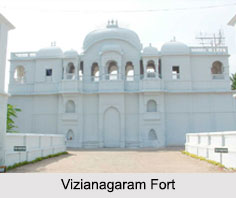 Located in the city of Vizianagaram in the state of Andhra Pradesh about 18 km from the Bay of Bengal, the Vizianagaram Fort was built by Vijaya Rama Raju, the Maharaja of Vizianagaram in 1713. The alternative name of the monument is called the Pusapati Fort.
Located in the city of Vizianagaram in the state of Andhra Pradesh about 18 km from the Bay of Bengal, the Vizianagaram Fort was built by Vijaya Rama Raju, the Maharaja of Vizianagaram in 1713. The alternative name of the monument is called the Pusapati Fort.
History of Vizianagaram Fort
While laying the foundation of the fort, it was very auspicious as it represented the five signs of victory, hence the name Vizianagaram, which is also a derivative of the founder"s name Maharaja Vijay Ram Raju. The site for building the Vizianagaram Fort was suggested to the Maharaja by a Muslim saint called Mahabub Valli, who was doing penance in the forest. And the date for the foundation ceremony of the fort corresponded to the Hindu calendar month of Ashwin on the tenth day of the festival of Vijayadashami.
Features of Vizianagaram Fort
Built out of stone, the Vizianagaram Fort is in the shape of square of 240 m in the side and rises to a height of 10 m. The width of the wall at the top varies from 8 to 16 m and the four corners of the fort have fortifications in the form of bastions made of stones with a slope on its inner face covered with earth fill and strengthened with stone slabs.
The Vizianagaram Fort has two architecturally elegant gates that followed the Rajasthani style of architecture. The main gate to the east is called the Nagar Khana as it has a drum tower at the top which was used to beat drums to inform the people of royal orders and arrival of royal guests. The other gate on the west has a pavilion on top and provides access to the royal tombs, and is a traditional gateway to take out dead bodies for cremation.
Apart from the two main gates, there are several temples and monuments located within the fort. Inside the fort there is a royal court called the Moti Mahal, which was built by Vijayarama Raju III in 1869 and upon entering the hall, there are two marble statues. Then there is the Oudh Khana, which is the opulent royal palace of the Rajas of Vizianagaram. The structure is 50 feet in height built with stones and has a spiral stairway which leads to the water tank at the top that is fed by pumping water from a nearby well.
The fort also has two other palaces called the Alakananda Palace, which is a royal guest house and the Korukunda Palace that is a sprawling 1000 acre land used as a playground. Educational institutions have been established in this land and there is a school to train youth who wish to join the defence forces.
Other than these, there is also a clock tower called the Ganta Stambham, which is patterned on the lines of the Big Ben in London. And outside the premises of the Vizianagaram Fort, there is an ancient temple dedicated to goddess Pydithalli Ammavaru, who is believed to be the reincarnated form of a daughter of the royal family. The image of the Goddess worshipped in this temple was found on Vijayadashami in 1752. This temple also is known to have a Shiva Lingam in two colours, which is said to exemplify the union of Lord Shiva and Goddess Parvati.
Visiting Information on Vizianagaram Fort
The nearest railway station is the Vizianagaram Junction at a distance of mere 3km from the fort and the closest airport is the Vishakhapatnam Airport at a distance of 55 km.



















